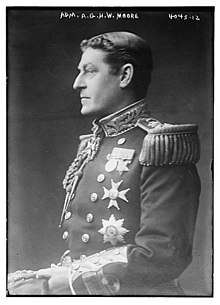Gordon Moore (Royal Navy officer)
Admiral Sir Archibald Gordon Henry Wilson Moore KCB CVO (2 February 1862 – 2 April 1934) was a Royal Navy officer who went on to be Third Sea Lord.
Sir Gordon Moore | |
|---|---|
 Moore in 1916 | |
| Born | 2 February 1862 |
| Died | 2 April 1934 (aged 72) |
| Allegiance | |
| Service/ | |
| Rank | Admiral |
| Commands held | 2nd Battlecruiser Squadron 9th Cruiser Squadron |
| Battles/wars | World War I |
| Awards | Knight Commander of the Order of the Bath Commander of the Royal Victorian Order |
Naval career
Moore joined the Royal Navy and served in the Anglo-Egyptian War of 1882.[1] He was promoted to Captain 17 July 1901,[2] and later Rear-Admiral. He was appointed Naval Assistant to the First Sea Lord in 1907 and Director of Naval Ordnance and Torpedoes in 1909.[1] He went on to be Third Sea Lord in 1912.[1] He served in World War I commanding the 2nd Battlecruiser Squadron from 1914 and then seeing action at the Battle of Heligoland Bight in August 1914 and then as Vice-Admiral Sir David Beatty's Second in Command at the Battle of Dogger Bank in which he led the sinking of SMS Blücher in January 1915.[3] He commanded the 9th Cruiser Squadron from February 1915 and went on to be Controller of the Mechanical Warfare Department in 1917.[1] He retired in 1919.[1]
References
| Military offices | ||
|---|---|---|
| Preceded by Sir Charles Briggs |
Third Sea Lord 1912–1914 |
Succeeded by Sir Frederick Tudor |